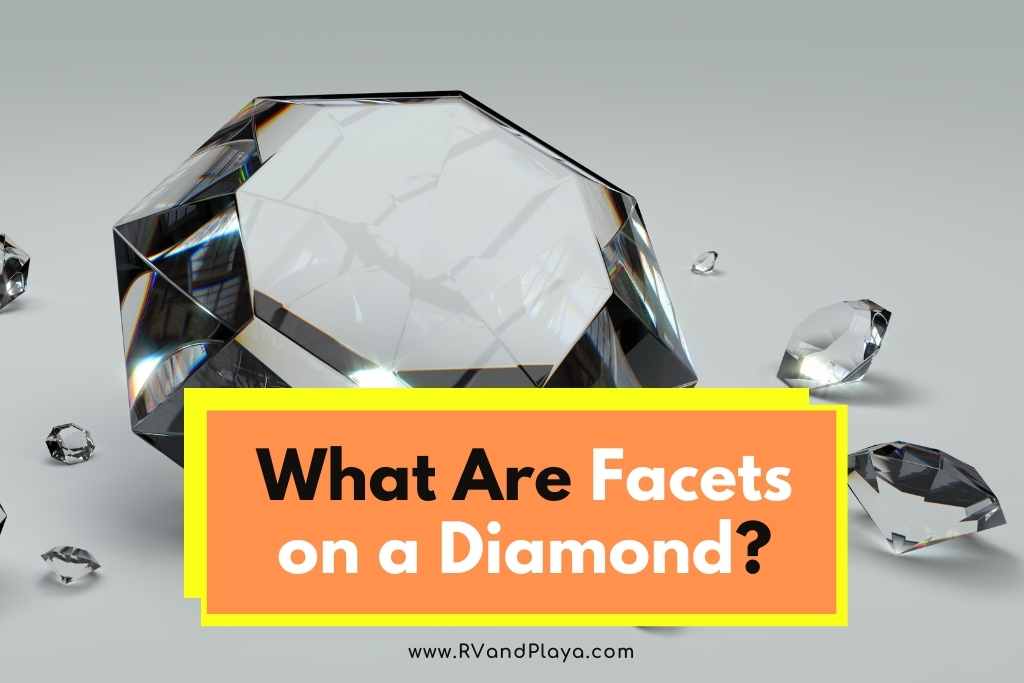Do you know what facets on a diamond are? Well, you are at the perfect place to find the answer to such a question.
Have you ever seen the sleek cuts and flat surfaces on diamonds, and wondered what purpose they serve, or how they came to be?
Facets on a diamond are the flat surfaces you see on top of the diamond, in jewelry or otherwise. There are multiple facets on the surface of a well-cut diamond, which help the diamond get its shape and reflect light brilliantly. The diamond facets are the work of experts, and require a lot of skill, since there are angles suited best for them to absorb and reflect right.
This article tells you all you need to know about the facets on a diamond, how they come to be, how they affect the visual appeal of the diamond and other related facts.
Table of Contents
What are facets on a diamond?
Before we tell you what facets are, you should know how a diamond gets the shape that you see in jewelry stores and advertisements.
Diamonds in their raw form are irregular, and thus need to be cut into the desired shape of the manufacturers. The term ‘facets’ is used in the world of gem cutting to describe a face, or flat side of a gem, including that of diamonds.
According to South Shore Diamond, the most important aspects of a diamond’s appearance rely on the arrangement of facets, which is to say that facets play a huge part in the visual appeal of any gem.
Now, what actually are facets? Facets are the flat or rounded surfaces on the gem usually in a geometrical pattern.
The facets are a result of intricate cutting of the diamond by experts and usually result in the shape that you see in stores.
The facets can be flat or rounded, depending on what kind of machine the cutters are using, or if they’re doing it by hand.
A tell-tale sign of a well-cut diamond is well-proportionate facets with optimal angles to reflect the light as it hits the diamond.
Read also >> How to Identify a Raw Diamond (Easy Explained!)
Read also >> Why Is Graphite Softer Than Diamond? (All You Need To Know)
What are the different diamond parts and facets?
A standard diamond has different parts to it, or sides, and each sides has multiple facets on it which help the diamond reflect light. According to the Diamonds Factory UK, the different parts of the diamond are:
- Crown – the top and angled section of a regularly cut diamond, usually known as the ‘face of the gem’
- Windows – the biggest flat surfaces/facets on the crown of the diamond
- Frames – lines separating individual facets
- Pavilion – the angled bottom of a diamond with multiple angular facets
- Girdle – the widest part of the gem
The different facets on these respective parts are as follows:
- Mains – can be the upper main facets (crown) or the lower main facets (pavilion). This is considered the largest facet on a diamond.
- Break facets – these are responsible for adjoining girdle on either sides of the diamond.
- Table facets – the horizontal facet on top of the gem or the crown.
- Star facets – join the table facet to the edge of the diamond crown.
- Pavilion facets – are located on the underside of a gem.
- Culet – also known as the pointy bottom of a diamond, sometimes included in facets. A culet is the intersection point of the facets placed alongside the pavilion of the diamond.
- Save an Average of $350* on Lab-Created Diamonds
- James Allen is the leader in online diamond sales
What purpose do facets serve on a diamond?
These above mentioned facets collectively not only give a diamond its shape but also give it the ability to absorb and reflect light rays, which is one of the main qualities of a diamond.
It not only makes the diamond appear shinier, but also more visually appealing to look at, because of the now smoother and more refined surfaces and sides, a.k.a. facets.
However, there are specific functions that each of these facets serves; the facets on the crown are expansive and allow as much light as they can to be momentarily absorbed into the diamond. This facet also gives a clear view of the inside of the diamond.
The windows on the crown have facets that allow for light to enter the open space and transform it into colored light.
The facets on the frame (break facets) are known to scatter light in the most beautiful way possible. They not only absorb light but are also responsible for neutralizing it and distilling to produce beautiful and visually mesmerizing sparkles.
The facets on a pavilion reflect redirect the light after it has entered the diamond through the crown. They reflect and disperse light from within the surface back into the open.
What are the different kinds of diamond shapes and how many facets do they have?
An average diamond with 57-58 facets will have 33 on the crown of the diamond connected to the girdle, and 24 on the pavilion.
However, there are different shapes that a diamond can be cut in and differing amounts of facets. The variety of shapes that diamonds come in are:
- Round Brilliant – as the name suggests, a rounded brilliant is in the shape of a circle, with 57-58 facets.
- Emerald – looks like a rounded rectangular spider’s web with an average of 58 facets.
- Cushion – with a chunky cushion look, cushion cut has 58 facets.
- Oval – similar to round brilliant, with 58 facets.
- Heart – has 56-58 facets, with 6-8 facets on the pavilion.
- Radiant – similar to Asscher but it has as much as 70 facets per diamond, which is a lot considering most have only 58 facets. Their cut is similar to Round Brilliant.
- Marquise – made with 57 kite-shaped facets.
- Princess – a princess cut diamond is a boxy square at first glance, and has sharp and accurate corners. Most princess cut diamonds have as many as 58 facets, although some can also have 50 facets in total.
- Pear – also called ‘tear’ shaped, this diamond has 58 facets, with 4-8 pavilion facets.
- Asscher – a royal Asscher has 74 facets, however, a normal Asscher has 50-58 facets. Asscher shaped diamonds look like a rounded square spider-web and have an elegant step-cut faceting, their shape is also wider than most diamonds.
Are more facets better for a diamond?
A diamond with more facets may have more clarity and luster rather than shine and brilliance, but it’s not necessarily good or bad, it all depends on what the manufacturers prefer their diamonds to look like.
Rather than the facets, it’s actually the cut and skill with which the diamond is cut which should be looked out for more when purchasing a diamond.
Diamonds Facets FAQs
1. How many facets does a regular diamond have?
The gold standard for facets is 58, so most diamonds have 58 facets (including the culet).
2. Do facets differ according to diamond shape?
The number of facets a diamond has depends on the cut and shape. Most diamond shapes have 58 facets in total, however, there are diamond shapes with lesser facets than average.
3. Which diamond shape has the most facets and why?
Even though a round brilliant cut is known to have the most facets (70), it is actually a royal Asscher which has the most number of facets, being 74 in number.
4. What happens if there are more than regular facets on a diamond?
More facets mean numerous smaller reflections instead of bigger ones.
5. Does the color of the diamond affect the reflectivity of the facets?
Yes, some darker colors do affect the reflectivity of diamonds.
James Allen is the leader in online diamond sales. Their imaging technology is the same as inspecting a diamond with a jeweler's loupe. They have the largest exclusive loose diamond inventory online and fantastic prices.
They also have the nicest collection of lab created diamonds online. Save 10% off select lab grown diamonds and 25% off ring settings during limited time sale!
WHAT WE LOVE ABOUT THEM:
- No questions asked returns within 30 days of shipment. James Allen will send you a paid shipping label to return the ring.
- Lifetime Warranty
- Free International Shipping
- Free prong tightening, repolishing, rhodium plating and cleaning every 6 months
- Provide insurance appraisals
- One free resizing within 60 days of purchase
- Free ring inscriptions
- Best-in-class high quality imagery of all diamonds in stock
- 24/7 Customer Service
- Best-in-class packaging
Conclusion
By now we hope you’ve found out what facets on a diamond are, why they’re important, and the role they have to play in a diamond’s beauty and visual appeal.
While the number of facets does not matter for a diamond, the cut is what determines how rare the diamond would be.
Facets determine the reflectivity of a diamond, how shiny it would be when exposed to any form of light, and how many sparkles it would produce.
References
https://www.diamondsfactory.co.uk/blog/ultimate-guide-to-diamond-facets
Recent Posts
Do you know how to identify a raw diamond? Well, you are at the perfect place to find the answer to such a question. A raw diamond does not look like the polished gemstone you're used to seeing....
Whenever you wear diamonds daily, it can feel like a hassle to remove the jewelry before every shower and put them back on after. For this reason, many people wear their diamonds and luxury jewelry...


